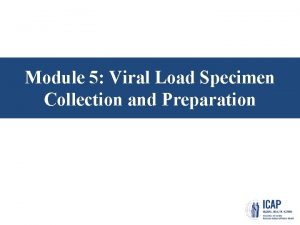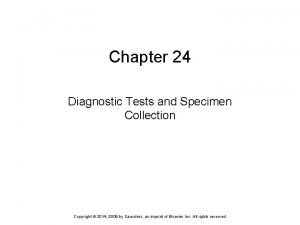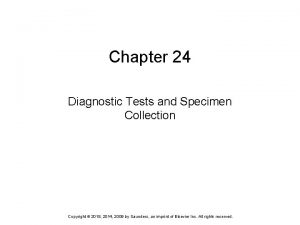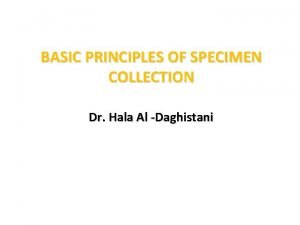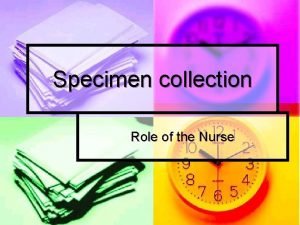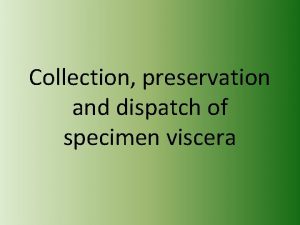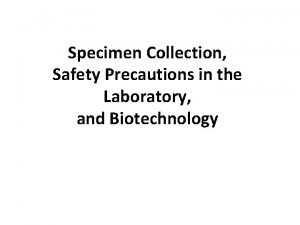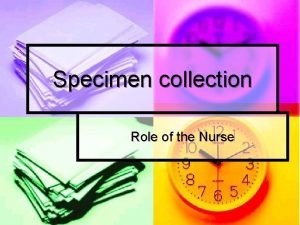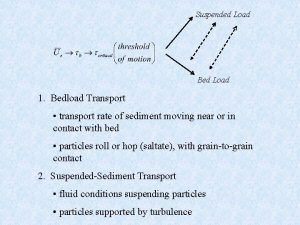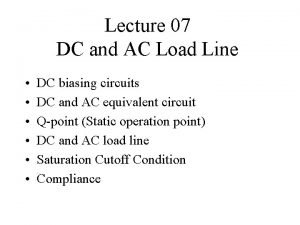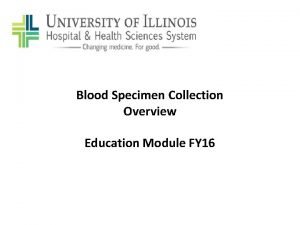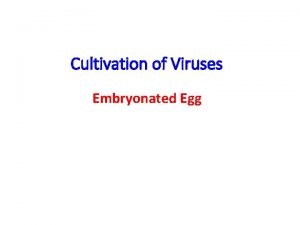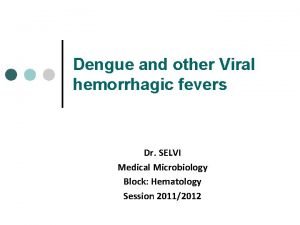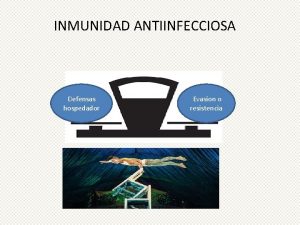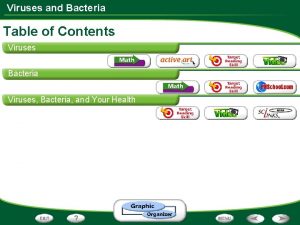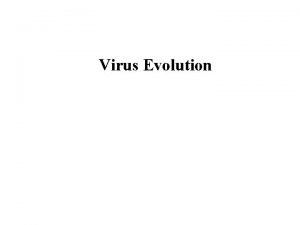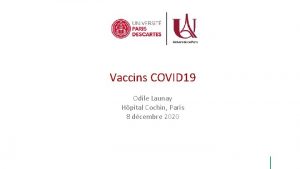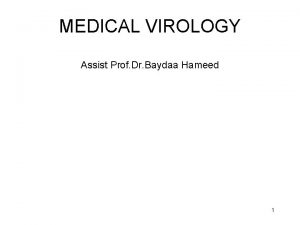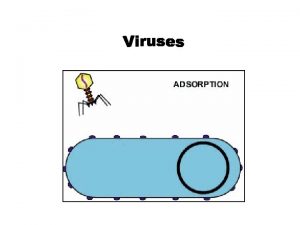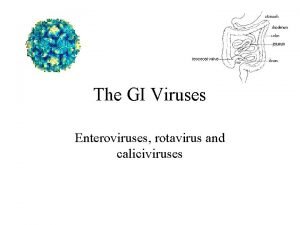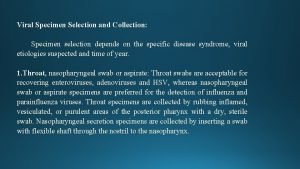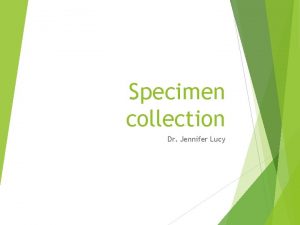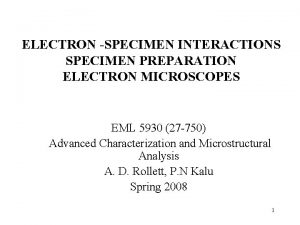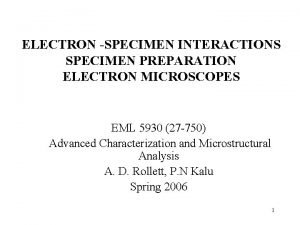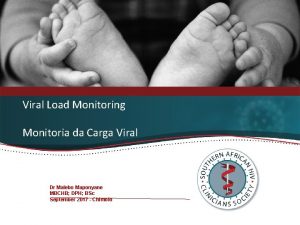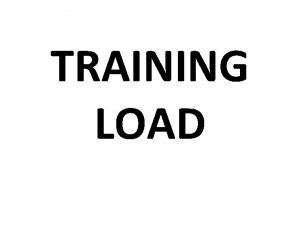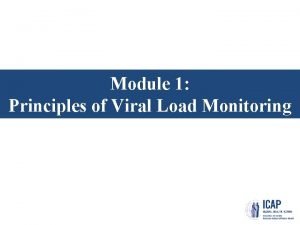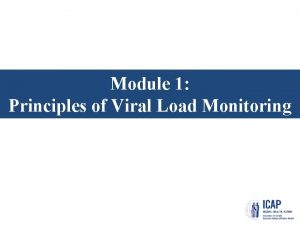Module 5 Viral Load Specimen Collection and Preparation






































- Slides: 38

Module 5: Viral Load Specimen Collection and Preparation

Learning Objectives • Learn the types of viral load test specimens • Understand the process of venous blood specimen collection • Understand the process of dried blood spot specimen collection • Describe elements of bio-safety

Outline • • Viral Load Test Specimens Venous Blood Specimen Collection Dried Blood Spot Specimen Collection Bio-safety

Viral Load Test Specimens Specimen types: Plasma Dried Blood Spot (DBS)

Using DBS vs. Plasma for Viral Load Testing Feature Plasma DBS Requires venipuncture Yes No Requires centrifugation Yes No Stable at “room temperature” No Yes* Biohazard for shipping purposes Yes No Dry ice required for shipping Yes No* Routinely used for genotyping Yes No Volume range 1 -5 ml 0. 25 -0. 5 ml *If kept dry, for at least 2 weeks

Venous Blood Specimen Collection

Materials Required for Venous Blood Specimen Collection • Vacutainer evacuated • blood collection tubes • • Vacutainer needle & needle holder • • Cryo (Nunc) tubes • Non-powdered gloves • Alcohol swab • Gauze sponges • Tourniquet Bandage Sharps disposing container Permanent marker

Venous Blood Specimen-Collection • Blood collection should be done using nonpowdered gloves. • Blood should be collected in a sterile tube using EDTA (purple top) only. • Collect about 5 ml of blood sample using EDTA vacutainer tube from adult patients. • Specimen should be sent to testing or facility laboratory within 24 hours (ideally 6 hours) of collection to spin the blood and extract the plasma.

Venous Blood Specimen-Processing • Separate plasma by centrifugation at 800 -1600 x g for 20 minutes or 2450 x g for 10 minutes at room temperature. • Transfer plasma to a sterile polypropylene (Cryo) tube. Be careful not to disrupt the buffy coat to prevent contamination with cellular material. • Transfer a minimum sample volume of 1. 2 m. L or 1200μL aliquots into each of two properly labeled polypropylene tubes. • Be sure that the polypropylene tubes are properly screw-capped.

Venous Blood Specimen-Storage • Specimen processing and storage facility need to have proper equipment and consumables. • Store plasma specimens at 2 -8 C for up to 5 days, or frozen at -20 to -70 C or colder. • Plasma specimens can be stored for only up to 24 hours at 15 -30 C. • Plasma specimens are stored at -70 C if longer storage is required. Specimen Type Storage Time Storage temperature 37 o. C 15 -30 o. C 4 o. C -20 o. C -70 o. C Whole blood 24 hrs NA NA NA Plasma 24 hrs 5 days 1 yr 5 yrs

Venous Blood Specimen-Transport • Specimens must be protected from mechanical damage, thermal shock and tampering. • Maintain integrity of the sample: – Whole blood must be transported at 2 -25 C and processed within 24 hours of collection. – Plasma may be transported at 2 -8 C, or in frozen state at -20 to -70 C if already frozen. • Assure safety regulations are met. – Triple packaging

Triple Packaging

Venous Blood Specimen- Rejection Criteria • Insufficient sample volume • Sample is clotted • Lipemic and hemolyzed specimens • Possible contamination • Poor separation of plasma • Plasma samples are NOT separated within 24 hours after collection • Specimens collected with non-EDTA anticoagulation (HEPARIN or ACD) • Plasma samples kept NOT frozen for more than 5 days before tested • Plasma samples are frozen and thawed greater than 5 times before testing • Plasma specimens are not stored at appropriate temperatures during transportation • No/poorly labeled specimen tube • Missing sample or lab request form

Venous Blood Specimen- Rejection Criteria Valid serum and plasma Hemolyzed Lipemic Contaminated

Dried Blood Spot (DBS) Specimen Collection

Materials Required for DBS Specimen Collection • Gloves (powder free) • Whatman 903 collection card • Card drying rack • Retractable lancet • Alcohol swab • Dry sterile gauze pad • Desiccant pack • Humidity indicator cards • Plastic humidity-proof zip-lock bags • Waterproof marker • Glassline paper (weighing paper) • Benchtop biohazard waste bag and holder • Sharps container • Pen

DBS Specimen Collection • Use universal safety precautions • Use of validated, perforated DBS cards is strongly recommended • Clearly label card with identification number • Blood collection should be done using non-powdered gloves • Blood can be collected from finger/heel pricks or from venipuncture in a sterile tube using EDTA (purple top) • If necessary, the EDTA anti-coagulated blood can be stored for up to 24 hours before DBS preparation, preferably at 4 C • Spot 5 full circles of blood directly onto the DBS card, or use transfer pipettes for venous collection

DBS Collection Tips • Do not touch the areas of the card that will be used to collect specimens whether gloved or ungloved. • Do not apply blood to both sides of the filter paper. • Do not apply blood more than once in the same collection circle. • Do not apply blood from more than one patient on the same collection card. • Do not press the filter paper against the puncture site.

DBS Specimen-Storage • DBS specimen should be air-dried before packaging, preferably for 4 hours or overnight. • Specimen should be stored in an air-tight ziplock plastic bag with desiccants and humidity indicator cards. • Avoid storage of dried blood spot cards at room temperature for more than one week. • Avoid exposure to direct sunlight and heat. • Cards must be labeled with appropriate identifiers.

DBS Specimen-Transport • Maintain integrity of sample – Temperature monitoring during transport – Monitor status of the humidity indictor – Time limitation • Assure safety regulations are met – Treat DBS as bio-hazardous material (but doesn’t require triple packaging)

DBS Specimen: Acceptable Sample • Identifying information on the DBS card must be clear and match accompanying paperwork. • At least 3 good spots must be obtained. – Samples should fill the circles and be as centered as possible, especially in the case of perforated cards. • After drying, DBS should be dark and a uniform color, indicating proper collection and drying technique.

DBS Specimen: Rejection Criteria • • Insufficient sample volume/incomplete circles Clotted sample Hemolysis/serum ring Abraded/scratched Not dry/packed before drying Poor humidity control No/poorly labeled specimen Missing sample or lab request form

Rejection Criteria: Can’t Read Identification Problem: The ID information cannot be read, so this sample should not be tested

Rejection Criteria: Can’t Read Identification Solutions: • Label the DBS card neatly before taking a sample • If the name can’t be read, another sample is needed

Rejection Criteria: Not Enough Blood Problem: These spots do not have enough blood to be tested. Remember, at least 3 GOOD SPOTS are needed for testing.

Rejection Criteria: Not Enough Blood Solutions: • If finger or heel prick, making sure the area is warm and properly positioned will help blood flow well for sample collection. • Don’t squeeze right on the puncture site, squeeze the whole foot or hand. • If blood has stopped flowing from where you pricked, a second prick at another site may be necessary. • A sick or dehydrated person may need venipuncture. • Ensure pipette is set to 70 u. L.

Rejection Criteria: Layered or Clotted Blood Problems: • Note the spots are darker in the center. This happens if you put wet blood on top of dry blood. • This may also have been made by using clotting blood.

Rejection Criteria: Layered or Clotted Blood Solutions: • Touch the card to a blood drop when it looks heavy and ready to fall. This is the right amount of blood. • If a drop is too small, and it is still wet, another drop can be placed on top. Otherwise, move to another spot. • Never use clotting or clotted blood to make a DBS.

Rejection Criteria: Serum Rings/Alcohol Contamination Problems: • The yellow ring around the blood spots means the blood is contaminated or separated. • The alcohol may not have dried. • This can happen from squeezing the puncture site – plasma may leak out instead of blood. • Also could be due to lack of mixing of EDTA tube prior to spotting.

Rejection Criteria: Serum Rings/Alcohol Contamination Solutions: • After cleaning the area, allow the alcohol to dry for 30 seconds before blood draw or prick. • Use gentle squeezing of the whole hand or foot to encourage blood flow. Never directly “milk” or squeeze the wound site. • If making DBS from EDTA tube, be sure to invert tube to mix blood several times prior to pipetting.

Rejection Criteria: Too Much Blood Problems: • This blood may have been applied with a syringe or incorrectly set pipette. • The blood has soaked through the other side of the card.

Rejection Criteria: Too Much Blood Solutions: • Use EDTA tube for venipuncture. • Use appropriate pipette set at appropriate volume for spotting DBS. • Do not overfill.

Rejection Criteria: Poor Collection Technique Problems: • Blood may have been clotting when dropped on the card. • More than one drop was applied to each circle. • None of the circles are filled well.

Rejection Criteria: Poor Collection Technique Solutions: • Wait for a large drop to collect before touching blood to the paper. • A drop of blood that falls on its own is the perfect size. • Never touch the skin, a needle, syringe, or pipette tip to the paper when applying blood.

Bio-Safety

Bio-Safety • All individuals handling blood specimens in any of the collection, processing and transportation steps must follow standard safety practices for dealing with potentially infectious biological material. • The reduction of biohazard exposure is achieved through the combination of safe practices and procedures, safe facilities, and safety equipment that allows the containment of biohazards. • Standard operating procedures outlined by National Laboratory Services for use of personal protective equipment, decontamination of reusable accessories such as cooler boxes, and decontamination and disposal of biohazard spills and wastes should be followed.

Bio-Safety • In the event of an accidental spill, the sample transporter should manage the spill using standard protocols for biohazard management. • For spills and any transportation delay, an incident report must be completed on the Specimen Tracking Form for quality assurance purposes. • Clinicians facilitating specimen transport should follow appropriate standard operating procedures for the process.

Questions?
 Sample rejection criteria
Sample rejection criteria Chapter 24 diagnostic tests and specimen collection
Chapter 24 diagnostic tests and specimen collection Chapter 23 specimen collection and diagnostic testing
Chapter 23 specimen collection and diagnostic testing Principles of collection of specimen
Principles of collection of specimen Nurses responsibility in collection of urine specimen
Nurses responsibility in collection of urine specimen Collection of specimen introduction
Collection of specimen introduction Safety precautions in blood collection
Safety precautions in blood collection Role of nurse in specimen collection slideshare
Role of nurse in specimen collection slideshare Taper roller bearing advantages and disadvantages
Taper roller bearing advantages and disadvantages Red dot
Red dot Suspended load definition
Suspended load definition What is dc load line
What is dc load line Section 24-1 viral structure and replication
Section 24-1 viral structure and replication Landsat collection 1 vs collection 2
Landsat collection 1 vs collection 2 Documentary collection definition
Documentary collection definition Finding answer through data collection
Finding answer through data collection Order of draw
Order of draw Aerochamber definition
Aerochamber definition Replicação viral ciclo lítico e lisogênico
Replicação viral ciclo lítico e lisogênico Viral replikasyon basamakları
Viral replikasyon basamakları Method of cultivation of virus
Method of cultivation of virus Viral inoculation in embryonated egg
Viral inoculation in embryonated egg Cultivation of viruses
Cultivation of viruses Spasmodic croup vs viral croup
Spasmodic croup vs viral croup Dea anggraini viral
Dea anggraini viral Morfologia viral
Morfologia viral Bacilos gram positivos meningitis
Bacilos gram positivos meningitis Causes of viral hemorrhagic fever
Causes of viral hemorrhagic fever Inmunidad
Inmunidad Capsid capsomere
Capsid capsomere Viral
Viral Viral recombination
Viral recombination Vaccins à vecteur viral
Vaccins à vecteur viral Viral receptors
Viral receptors Procalcitonin
Procalcitonin Equine viral rhinopneumonitis
Equine viral rhinopneumonitis Viral dna
Viral dna Rotarix live attenuated
Rotarix live attenuated Viral entry
Viral entry
